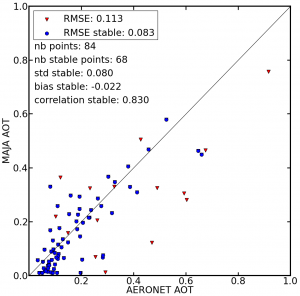We are continuously working on improving the Sentinel-2 L2A products delivered by Theia. Since the 2nd of February, a new parametrization was put in production in order to improve two points of the cloud masks. There is a page which summarizes the variations of Theia product versions. Because of some error within Muscate production centre, we are not able to change the product version when we change a parameter. You have to look at the production date to know which version was used. This inconvenience will be corrected soon.
Clouds above water
Although MAJA is optimized for cloud detection and atmospheric correction over land, it is important to detect clouds well over water. For instance to detect the shadows of these clouds that are cast over land. But until now, the clouds mask was missing quite a lot of clouds over water. This was not a surprise as we had passed only a few hours determining the thresholds to apply. We recently found some more time to obtain a better tuning of the detection thresholds above water.Thresholds in the SWIR have been halved (from 0.08 to 0.04), in the absence of sunglint. When sunglint is likely, due to the geometry of acquisition, the threshold is still higher (0.016, but it was 0.25 before).This means that when the sunglint flag is raised, the accuracy of cloud detection is reduced.
Cloud dilation
 |
 |
Left, aerosol validation results with a dilation of 240m, right with a dilation of 480m. The new result brings a significant improvement (Merci à Bastien Rouquié pour ce résultat)

